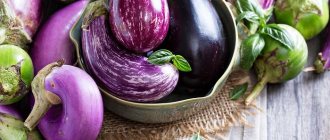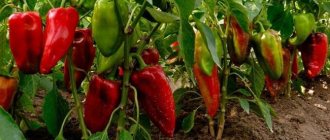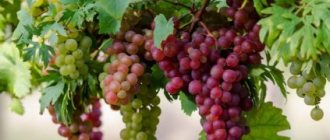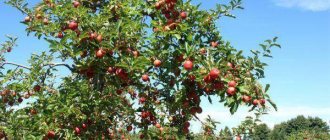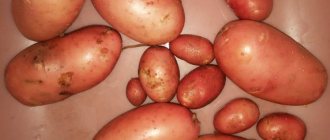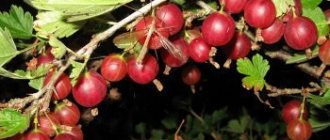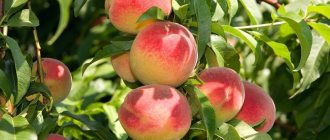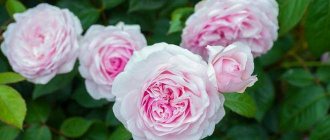The best varieties of peaches - TOP 10 most delicious, large and sweet
Redhaven
One of the best and tasty varieties. Brought out by US breeders in 1940. Occupies up to 70% of all peach plantings in this country. It has good transportability and high frost resistance (up to -25°C). Not resistant to peach curl.
- Tree height – up to 5 m
- Flowering period: late April to mid-May.
- Productivity – up to 60 kg per tree.
(at the age of 5 years)
- The average fruit weight is 120-200 g.
- The fruit is juicy and sweet. 4.9 points out of 5.
- The color of the pulp is bright orange with crimson veins.
- Skin color – yellow with a bright red blush
dav
Jaminat
First registered in Dagestan. Included in the State Register of the Russian Federation in 2000. Fruiting is annual and is not damaged by spring frosts. Relatively resistant to curl and cluster blight. Begins to bear fruit at 3-4 years.
- Tree height is from 2.5 to 4-5 m.
- Flowering period is April.
- Productivity – 110 c/ha.
- The average fruit weight is 130-160g.
- The fruit is juicy and sweet. 4.7 points out of 5.
- The color of the pulp is orange-yellow.
- The skin color is orange with a red blush.
Golden Moscow
Bred in the Nikitsky Botanical Garden. This peach differs from others in that its flowering begins a week before the leaves appear. The taste is very high, but frost resistance is average. Very poorly transported. Has high immunity to fungal diseases. To enlarge the fruits, it is necessary to normalize the flower ovaries.
- Tree height – up to 4 m.
- Flowering period is April-mid-May.
- Productivity – up to 50 kg per tree.
- The average fruit weight is up to 180 g.
- The fruit is juicy and sweet. 4.8 points out of 5.
- The color of the pulp is yellow-orange with red splashes.
- The skin color is bright yellow with a red blush.
Kremlevsky
Bred by breeder I.N. Ryabov in the Nikitsky Botanical Garden. Adapts well to any climatic conditions. The swollen buds can withstand frosts down to -6°C. The fruits are not the same in size; to enlarge, it is necessary to normalize the number of buds. Has high resistance to fungal diseases.
- Tree height – up to 5 m.
- Flowering period – April – early May.
- Productivity is about 40 kg per tree.
- The average fruit weight is 100-200g.
- The fruit is juicy, sweet, with a pronounced peach aroma.
- The color of the pulp is yellow.
- The skin color is yellow-orange with a bright red blush.
Fury
Brought out in the USA in 2000. It is considered the record holder for the largest fruit, but this requires regular feeding and watering. Peaches ripen almost until September, which is a serious disadvantage for the widespread distribution of the variety. It has high frost resistance (up to -28°C).
- Tree height is from 2.5 to 4-5 m.
- Flowering period is April.
- Productivity – up to 60 kg per tree.
- The average fruit weight is 300-400g.
- The fruit is juicy, sweet, very tasty.
- The color of the pulp is orange.
- The skin color is orange, almost without blush.
Frost
This variety was also bred in the USA. It has good keeping quality and high (up to -30°C) frost resistance. Among the disadvantages of the variety, it is necessary to note the difficulty of care - pruning to correct the crown throughout the season, frequent and regular watering, and fertilization.
- Tree height – up to 3.5 m.
- Flowering period - late April - early May.
- Productivity – 40-50 kg per tree.
- The average fruit weight is 180-200g.
- The fruit is juicy, sweet and sour, tasty, with a strong aroma.
- The color of the pulp is yellow.
- The skin color is yellow with a large red blush and uneven pubescence.
White Swan
Bred in Crimea, in the Nikitsky Botanical Garden. The main characteristics are self-fertile, drought-resistant, frost-resistant. Ripens in August. The fruits are not stored for long and are transported only short distances. They have an unusual flesh color. Resistant only to powdery mildew and cluster blight. It has poor resistance to other diseases, in particular leaf curl. Fruiting is regular, annual.
- Tree height – up to 3.5 m.
- Flowering period is mid-April.
- Productivity – 50-60 kg per tree.
- The average fruit weight is 150-200g.
- The fruit is juicy, sweet, very tasty, with notes of honey.
- The color of the pulp is light yellow, almost white.
- The skin color is creamy, almost without blush.
Collins
Bred in the USA, in the state of New Jersey. Self-fertile, early variety. It has poor frost resistance and freezes at a temperature of -20°C. It is quite transportable and has an excellent presentation. Regular watering is required; it does not tolerate drought.
- Tree height – up to 3 m.
- The flowering period is from mid-April.
- Productivity is average, up to 30 kg per tree.
- The average fruit weight is 150 g.
- The fruit is juicy, sweet and sour, with a strong aroma.
- The color of the pulp is yellow-red.
- The skin color is orange with a pink-red blush.
Condor
An unpretentious variety bred by American breeders. Resistant to curl and fungal diseases. Self-pollinating, early ripening. It tolerates transportation well, because... The skin and pulp are quite dense. Frost-resistant and drought-resistant. Requires regular pruning throughout the season.
- Tree height – up to 4 m.
- Flowering period: April - early May.
- Productivity – 50-60 kg per tree.
- The average fruit weight is 180-200g.
- The fruit is juicy and sweet. 4.8 points out of 5.
- The color of the pulp is orange with red veins.
- The skin color is golden-orange with a slight blush.
Fleming Fury
USA selection. High winter hardiness, medium-late ripening period. The fruits are very large, according to this indicator - one of the champions, listed in the Guinness Book. Transportability is high, up to 5-6 days.
- Tree height is from 2.5 to 4 m.
- Flowering period is April.
- Productivity – 40-50 kg per tree.
- The average fruit weight is 270-300g. Up to 500 g with good agricultural technology.
- The fruit is juicy, very sweet and very aromatic.
- The color of the pulp is yellow, closer to the seed it is red.
- The skin color is yellow with a slight red blush.
SUCCESS OF AMERICAN BREEDING
The peach came to North America in several ways. It was brought to the northern half of the United States by English colonists, and to the southern half and Mexico it came from Spain. For a long time, peaches were propagated exclusively by seeds, which, of course, did not contribute to the quality of the product. And only at the beginning of the 19th century they began to produce budding seedlings, propagating in this way the most outstanding selected seedlings.
The climate of the eastern states of the United States turned out to be extremely favorable for peach. Even in the far north, in the Great Lakes region, summers are as hot and long as ours in Crimea and Kuban. Thanks to the presence of huge masses of water that soften winter frosts, the temperature in coastal areas does not drop below – 28 ºC even in the harshest winters. The same conditions exist in all areas along the Atlantic coast. As we approach the subtropics of Florida, the conditions for peach cultivation deteriorate, since due to too warm winters, many varieties do not fully go through the winter dormancy period, which leads to poor flowering and poor fruit quality. The peach has a much longer dormant period and does not react like the apricot to the long winter thaws and sudden transitions from thaws to frost that are characteristic of winters in the eastern states. Therefore, the peach quickly became one of the leading stone fruit crops in the United States.
'Shanghai Shui Mi' variety from China played an important role in peach breeding in the USA.
, which in English-speaking countries is called
'Chinese Kling'
(Chinese with a non-separating bone).
Originally brought to England in 1850 by the famous English plant hunter Robert Fortune, 'Chinese Kling' turned out to be unsuitable for the English climate due to its high heat requirement during the growing season. But when a few years later it came to the southeastern United States, all its positive properties were fully manifested. In 1870, breeder S. Rumph in the state of Georgia selected the varieties 'Elberta'
and
'Beautiful'
from Georgia among the seedlings of 'Chinese Klinga'.
The pollen of 'Chinese Kling' was sterile, so it was pollinated by some local varieties. These varieties - the white-fleshed 'Beautiful' from Georgia and the yellow-fleshed 'Elberta' - were head and shoulders above all varieties previously cultivated in the USA in terms of fruit quality. From self-pollination of 'Elberta' a very large-fruited and high-quality variety 'J.
Hale' , which has been widely used as a single parent in numerous breeding programs in many states. American varieties are so superior to others in fruit quality and technological characteristics that they have displaced local varieties from industrial horticulture around the world. Even in China, the homeland of peach, mainly US varieties are grown for sale.
Canadian breeders who worked at the Harrow and Vineland experimental stations also made a significant contribution to the improvement of peach. These stations, located in the extreme south of Canada in the Great Lakes region, are practically no different in climatic conditions from their neighboring US experimental stations (for example, the famous station in South Haven, Michigan). For breeding, they use the same source varieties as in the USA. The entire industrial peach culture in Canada is concentrated in the county of Niagara Falls, which is a narrow peninsula sandwiched between Lakes Ontario to the north and Lake Erie to the south and jutting deep south into the United States. Summers in this area are long and hot (average temperature in July +23 °C), and winters are mild (average temperature in January - 4 °C), the minimum temperature even in the most severe winters does not fall below - 27 °C. Therefore, in terms of winter hardiness, Canadian varieties do not differ significantly from most American ones.
The very narrow genetic basis of modern American varieties, originating from just a few original forms, has led to the fact that in terms of winter hardiness they are almost no different from each other. The T50 indicator used by American scientists, which means the temperature at which 50% of flower buds die, and is established by artificial freezing of shoots, for all industrial varieties ranges from 21 to 23 ° C and the differences between them are only tenths of a degree.
Early peach varieties
Morettini's favorite
Bred in Italy. It is considered the standard of early peach. Known in our country since 1987. The first fruits ripen at the end of June. It resists well to most fungal diseases, but frost resistance is low, so insulation for the winter is required in the middle zone.
- Tree height – up to 4 m.
- Flowering period is mid-April.
- Productivity – 25-35 kg per tree, maximum up to 50 kg.
- The average fruit weight is 130-150g.
- The fruit is tasty, juicy, aromatic.
- The color of the pulp is pale yellow.
- The skin color is yellow with red streaks.
Harrow Diamond
Canadian selection. It begins to bear fruit in the third year after planting. Withstands severe frosts and is well transported.
- Tree height – up to 4 m.
- Flowering period is mid-April.
- Productivity – 25-30 kg per tree.
- The average fruit weight is 90-150g.
- The fruit is sweet with pleasant sourness, juicy, aromatic.
- The color of the pulp is orange with red veins.
- Skin color is red with a yellow blush.
Kyiv early
Known in Ukraine since 1954. The tree is frost-resistant (up to -26-28°C), is self-fertile, but for abundant and regular fruiting it is still necessary to plant pollinators of other varieties. Affected by leaf curl. At a young age, the crown thickens greatly, so constant pruning is required.
- Tree height – up to 4 m.
- Flowering period is April.
- Productivity – 55-60 kg per tree.
- The average fruit weight is 100g.
- The fruit is juicy, with a delicate structure, very aromatic.
- The color of the pulp is white.
- The skin color is creamy yellow with a crimson blush.
Collins
The characteristics of the variety are presented above.
Stavropol pink
Brought out in 1959 at the Stavropol Experimental Station. Has good winter hardiness. It begins to bear fruit 2-3 years after planting. Self-pollinating, but with average disease resistance. The keeping quality of the fruit is low, as well as frost resistance, it requires shelter in severe frosts.
- Tree height – up to 5 m.
- Flowering period is mid-April.
- Productivity – up to 55-60 kg per tree.
- The average fruit weight is up to 135g.
- The fruit is tasty, sweet and sour.
- The color of the pulp is white, pink closer to the seed.
- The skin color is greenish-cream with a light crimson blush.
Features of cultivation and care
In order for the harvest to be regular, it is necessary to observe the cultivation characteristics that are directly suitable for central Russia.
Recommendations for choosing deadlines
In order to regularly obtain a harvest, the crop should be planted in early spring, before the buds swell. The late period can lead to incomplete ripening of the fruit.
Requirements for location and soil
In order for the harvest to be regular, it is important to choose the right place for planting the crop. Peach is a heat-loving plant, so when planting a seedling it is important to observe the following features:
When planting peach in clay soil, it is important to ensure proper drainage so that the liquid does not stagnate. Excessive moisture can lead to rot and disease.
Preparing the site and pit
Before planting a seedling, it is necessary to clear the area, removing weeds and debris. The soil is dug up and treated with special preparations that remove pest larvae. Before planting a seedling, you must first prepare the planting hole:
The distance between seedlings should be at least 1.5 meters. This distance is necessary so that the roots have enough nutrients for normal development.
How to select and prepare planting material
To obtain a harvest, it is important to choose the right planting material:
During planting, all buds must be dormant, otherwise the plant may die.
Planting scheme
During landing, you must perform the following algorithm of actions:
Make a hole and pour plenty of water, at least 2 buckets.
Adaptation period
A correctly planted plant quickly adapts to a new planting location. On average, a plant adapts to a new location within 2 weeks.
Watering mode
In order for the plant to quickly go through the adaptation stage, it is necessary to ensure timely watering. The crop needs to be watered once every 7 days. You need to use 2-3 buckets of water. After the seedling takes root, irrigation is carried out once every 20 days; if hot weather conditions are observed, the moisture regime increases.
Feeding
The first fertilizing begins only 2 years after planting. In subsequent years, fertilizing is applied twice a year:
If soil depletion is observed, it is necessary to add additional superphosphate in mid-summer.
Formation
To increase fruiting in central Russia, it is necessary to carry out timely pruning. Pruning must be done immediately after planting. The branches are shortened so that a ball-shaped crown is formed. This will help increase productivity.
Preparing for winter
In order to preserve the health of the crop, it is necessary to provide shelter for the winter period. More often, special structures made of foam or wood are used for shelter. However, you can use plastic film, making holes in it for ventilation.
This will prevent mold from forming.
Important. In early spring, it is necessary to ventilate structures to prevent fungal diseases.
Diseases and pests
Improper care often leads to the appearance of diseases and pests. Such problems lead to a lack of harvest and the death of the tree.
Moniliosis
A fungal disease that affects the fruit and makes it unfit for consumption. The disease can affect buds and leaves; the fungus looks like a burn. As a result, the process of rotting begins.
The disease quickly spreads to healthy areas and can destroy the plant in a short time.
For treatment, it is necessary to remove the infected areas of the tree and spray the crop with an antifungal drug.
Powdery mildew
It often appears at the end of bud formation. The disease occurs on the leaves and causes them to fall off. Rose can also attack unripe fruits, manifesting itself in the form of a white coating, which leads to fruit falling. For treatment, it is necessary to use the drugs “Topsin” and “Topaz” three times a season.
An insect that feeds on plant sap. The pest attacks young shoots and causes them to wither. To combat it, you need to use Bordeaux mixture, a solution of laundry soap or copper sulfate. Treatment is carried out until the pest is completely removed.
Medium peach varieties
Golden Jubilee
An American variety, obtained in the state of Jersey. It was introduced back in 1920, but has not yet lost its popularity. It appeared in our country in 1947. Does not have sufficient frost resistance. The first fruits can be collected in the third year of fruiting.
- Tree height – up to 5 m.
- The flowering period is the first ten days of May.
- Productivity – up to 50-60 kg per tree.
- The average fruit weight is 120-140g.
- The fruit is sweet and sour, very tasty.
- The skin color is golden yellow, honey-colored with a large bright red blush.
- The color of the pulp is orange-yellow, pink closer to the seed.
Veteran
Canadian selection in 1925, in our country since 1948. It is still very popular. Winter hardiness is above average (-20-22°C), but in severe frosts it dies. Does not require abundant watering and can withstand extreme heat. It begins to bear fruit in the third year.
- Tree height – up to 3.5 m.
- Flowering period - end of April.
- Productivity – 45-50 kg per tree.
- The average fruit weight is 135-185 g.
- The fruit is juicy and very aromatic.
- The color of the pulp is light yellow.
- The skin color is bright yellow with a large reddish blush.
Novoselkovsky
The variety has an average degree of frost resistance (up to -25-27°C). Does not tolerate shade. It is affected by leaf curl; preventative spraying is needed in the spring; immunity to other diseases is good. It begins to bear fruit 4-5 years after planting. Gives a high yield only in the presence of a pollinator.
- Tree height – up to 3 m.
- Flowering period – April – early May.
- Productivity – up to 30-50 kg per tree.
- The average fruit weight is 60-80 g.
- The pulp of the fruit is tender, sweet, with a slight sourness.
- The color of the pulp is white or greenish-white.
- The skin color is greenish-cream with a blurred, dim, striped blush.
Ambassador of Peace
Relatively recently, in 2014, it became known to Russian gardeners. Gives a stable harvest. Tolerates transportation well. Branches may break during a heavy harvest, so supports are required.
- Tree height is up to 4-5 m.
- Flowering period - late March - early April.
- Productivity – up to 50 kg per tree.
- The average weight of the fetus is 180-210 g.
- The fruit has a pleasant, sweet and sour, harmonious taste.
- The color of the pulp is yellow.
- The skin color is yellow with a large carmine blush.
Peach varieties for different regions of Russia
For central Russia and the Moscow region, varieties that meet two criteria are suitable: high frost resistance and early ripening. Almost the same conditions are needed for peach varieties created for the harsh climate of the Urals and Siberia.
For the Moscow region
Juicy
Bred in 1947 in the Nikitsky Botanical Garden. Winter hardiness is high - up to -25°C. Due to the melting, very juicy pulp, the fruits must be eaten or processed almost immediately and cannot be transported. Drought-resistant, self-fertile, does not require a pollinator. Susceptible to powdery mildew.
- Tree height is up to 3.5-4 m.
- Flowering period is the second half of April.
- Productivity – 50-60 kg per tree.
- The average fruit weight is 125-200 g.
- The fruit is sweet and sour, very juicy, aromatic.
- The color of the pulp is greenish-white with red veins.
- The color of the skin is greenish-cream with a blurred carmine blush and streaks over almost the entire surface of the fruit.
Early champion
It has been known among gardeners since 1991 and is one of the popular varieties grown in the Russian Federation. It has high frost resistance down to -30°C, but in the conditions of the Moscow region a small shelter is still recommended. The buds can withstand frosts down to -8°C, and blooming flowers up to 0°C. It begins to bear fruit 3-4 years after planting.
- Tree height is up to 3-4 m.
- The flowering period is early May, the fruits can be collected in the second half of July.
- Productivity – up to 60-70 kg per tree.
- The average fruit weight is 150-170 g.
- The fruit is tasty, sweet, aromatic.
- The color of the pulp is bright yellow.
- The skin color is bright orange with a slight pink blush.
Greensboro
American ancient selection, bred in 1891. It appeared in the Russian Federation in 1947. begins to bear fruit 3-4 years after planting. The tree is self-fertile, but the presence of a pollinator significantly increases the yield. The fruits are very poorly stored and with minor damage quickly darken. May be affected by clasterosporiosis. Frost resistance is high, up to -25-30°C, according to some data up to -35°C.
- Tree height – up to 3 m.
- Flowering period - early May.
- Productivity – up to 60-70 kg by the age of 10 years.
- The average fruit weight is 110-120 g.
- The fruit has a pleasant, sweet and sour, harmonious taste.
- The color of the pulp is soft cream with a greenish tint.
- The skin color is greenish-cream with a slight burgundy blush.
For the Urals and Siberia
Getting a good harvest of peaches in these regions is very problematic. The point is the return frosts, which can kill both unopened buds and blossoming flowers. But still, there is experience in growing peaches in these regions, and even varieties have been bred that can produce at least a small, but quite satisfactory harvest of fragrant fruits.
Uralets
Bred in 2003 in Nizhny Tagil, Sverdlovsk region. It can withstand frosts down to -42°C, but nevertheless, if possible, at least a light shelter would not be amiss. It begins to bear fruit in the third year of life.
- Tree height is up to 2.5-3 m.
- Flowering period is mid-May.
- Productivity is average.
- The average fruit weight is 150 g.
- The taste is sweet and sour.
Donskoy frost-resistant
Launched in 1960. Not only the tree itself, but also the flower buds are frost-resistant. Begins to bear fruit in the third year of life. Regular fruiting from mid-August to early September.
- Tree height is up to 3-4 m.
- Productivity - 40 kg in the conditions of the Urals with good agricultural technology.
- The average fruit weight is 60-80 g.
- The fruit has a sweet flesh with slight sourness.
- The color of the pulp is white, without redness at the pit.
- The skin color is yellow with a slight blush.
Michurinsky
For a guaranteed harvest, pollinators are needed, regular watering in hot summers and fertilizing. Frost resistance is high, the tree itself can withstand frosts down to -35°C, buds up to -20°C. Well stored and transported.
- Tree height – 2 m.
- Flowering period is April.
- Productivity is 20-50, in good years up to 100 kg per tree.
- The average fruit weight is 80-100g.
- The fruit is juicy, with a pleasant aftertaste.
- The color of the pulp is pale yellow.
- The skin color is yellowish with a blurred blush and streaks over the entire surface.
Video review of 6 peach varieties for harsh climates
The video presents peach varieties that will grow well in the conditions of central Russia, the Moscow region and Belarus. Description of varieties and important nuances of growing peach. Join the viewing!
Varieties of peaches for the southern region are not considered here for one simple reason - almost all varieties of this wonderful crop grow in the south. And if initially the peach was a heat-loving, capricious plant, then the painstaking work of breeders made it possible to significantly shift the distribution boundaries of everyone’s favorite fruit to the north.
What is the peculiarity of winter-hardy varieties?
Varieties of winter-hardy peaches are able to withstand significant cold snaps. Even in middle and northern latitudes they can easily endure wintering, but there are a number of important nuances that not all gardeners know about.
Criterion for winter hardiness of the tree itself and individual flower buds
- Each species has a certain criterion for the winter hardiness of the tree itself and individual flower buds. The frost resistance index of a crop can reach up to -40 degrees, but flower buds, as a rule, can withstand -22 below zero, if we talk about winter-hardy varieties. So, strong, late cold snaps in northern latitudes can still deprive a gardener of a harvest.
- Winter-hardy varieties need to be properly cared for. If the tree is heavily overloaded with fruits, then winter hardiness will greatly decrease by the coming winter. This indicator also reduces the age of the tree. The older it is, the less cold it can withstand.
